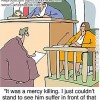
Dictionary.com defines the word conspiracy as “an evil, unlawful, treacherous, or surreptitious plan formulated in secret by two or more persons; plot,” and tells us that a theory is “a proposed explanation whose status is still conjectural and subject to experimentation, in contrast to well-established propositions that are regarded as reporting matters of actual fact.”
We can deduce from combining these two definitions that a conspiracy theory is a gathering of facts and other intelligence that suggests that a given event is the result of an evil or unlawful plot formed in secret. Close, right?
Almost everybody who is capable of thought loves a good conspiracy theory. The subjects are wide and varied and range from “Was George Washington a Freemason?” to “Did George W Bush not only previously know about but was he also partially responsible for the events on September 11th 2001?” What most of us refer to as the “crazy train” stops at just about every point in between.
The most famous conspiracy theory in the US is, of course, the murder of President John F Kennedy in 1963. The theories range from the idea that the US Mafia had him killed to the Cubans did it, the Soviets did it or, like Elvis and Tupac, JFK is really still alive and partying it up on Martha’s Vineyard. Note: As of today, September 4th, 2012, JFK would be 95 years old, so how much partying would he really be doing?
Most conspiracy theories do, however, contain some of the same elements.
The Elements Of Conspiracy Theories
Though every community has its own little conspiracy theories, the “big ones” happen on a national if not global level. They usually involve a tragedy or the death of someone famous. In the case of the Las Vegas shooting death of rapper Tupac Shakur in 1996, conspiracy theories were borne out of the lack of suspects and the investigating police department’s unwillingness to release information to the public.
There are several elements that conspiracy theories should have in order to spark public interest and/or outrage. Here are the most prevalent.
Most conspiracy theories begin with a big event.
There are many other examples we could use, but let’s use JFK’s murder, the “mother of all conspiracies” here. We have video footage of the shooting of the President and photographs from his autopsy also exist. For all intents and purposes, we will consider JFK as truly being deceased and as having become so due to at least one gunshot on November 22, 1963.
Some aspect of the event has to either be unexplained or the given explanation has to either be unbelievable or there will be too many holes or there has to exist at least the suggestion of a “cover up.”
Some conspiracy theorists believe that 1.) The video clearly shows that there were unexplained gunshots and the trajectories of those gunshots suggest that there was more than one gunman. 2.) There may have been a cover-up – stories and testimonies changed, especially with regards to the witnesses interviewed by the Warren Commission, an official government investigation into the assassination of JFK. 3.) The killing of JFK’s suspected murderer, John Harvey Oswald by Jack Ruby is considered by some to be evidence that Oswald either did not act alone, or he was following orders and that he was murdered to ensure his silence.
Two or more people need to agree on the purported “true” aspects of the event.
It is estimated that up to two-thousand books have been published which deal with the JFK assassination conspiracy in some aspect. Many people do not believe the government’s official story that explains the events of November 22, 1963, and have theorized on their own, with or without factual evidence, what actually happened on that day and the weeks and months leading up to it.
Those facts or beliefs need to ring true enough to convince other people they are the truth.
Because of the information that has been gathered concerning JFK’s assassination, many people do not believe that the explanation that the government gave to the American people is factual. At the very least, many consider it incomplete. In 2004, FOX News conducted a poll to find out what percentage of their viewers believed in the accuracy of the findings of the Warren Commission. According to the poll’s results, sixty-six percent of those responding believed that the assassination was part of a larger conspiracy. Seventy-four percent believed that there was a cover-up and only fourteen percent believed that the American public was given all of the facts.
The Truth As Who Knows It?
Theoretically, anything can have or become a conspiracy theory, but those four things must be present for the theory to become popular. The most prevalent conspiracy theories are the ones that get people thinking.
The important thing to remember when investigating conspiracy theories is to stick to the facts only. It can be easy to get swept up by passion or other emotions and, before you know it, you’re full-blown crazy too. Nobody wants to get caught with tin-foil on their heads. Seriously.
, What Makes A Good Conspiracy Theory? www.ozeldersin.com bitirme tezi,ödev,proje dönem ödevi
